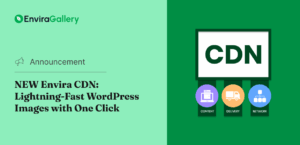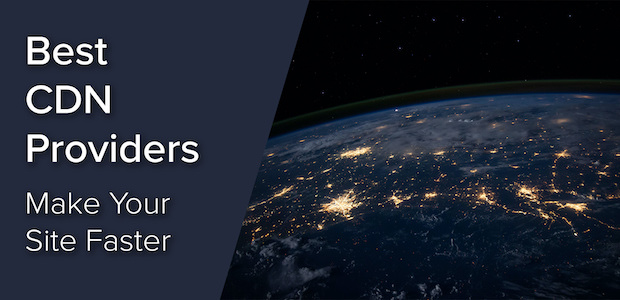Your website’s speed is important, regardless of your industry or niche. For a photographer – or at least an image-heavy website – it should be an essential attribute to have. A fast website means that visitors will be more likely to stick around, search engines can rank your site better, and much more. A Content Delivery Network (CDN) provider is geared towards helping your site stay speedy.
It does this through a network of servers. We’ll talk more about this throughout the article, but the ability to serve media assets such as photos from a server local to your user is the best way to boost your site’s speed. A CDN isn’t restricted to media assets, but it’s a big part of its responsibility.
Over the next few minutes, we’re going to run through some of the best CDN providers on the market. We’ll cover both free and premium solutions, across a range of applications. By the end, you’ll know which one will be right for you.
What a Content Delivery Network (CDN) Is
First off, we should discuss the concept of a CDN. The clue as to what the technology does is in the name. A CDN takes specific content, stores it within a network of servers, and delivers it when necessary.
In lots of cases, you’ll get to choose the site assets and dependencies you store away. In some cases, you’ll also get to decide upon the ‘data centers’ you use. If this is a new term to you, it’s a technical way to talk about the server and its location. There are often many of these across the world, and this is fundamental to the whole concept of CDNs.
Most internet connections happen between a client and a server. Of course, the typical situation is that the server is rooted in one location, and clients can connect from anywhere in the world. This produces a connection ‘length’ of various sizes. Short connections (in a relative sense) are faster than longer ones.
As such, visitors in different parts of the world will have a varied experience depending on their location. In lots of real-world cases, Australian visitors to US servers see poor connection speed compared to local ones.
In basic terms, a CDN places more servers around the world for those to access at a local level. This will store any and all of a site’s files and assets, then serve them on a per-user basis. The ideal is that the connection will be shorter, so the performance will increase.
Why You’d Want to Use a CDN For Your Photography Site
There’s a clear reason for any website to use a CDN: Speed. Though, there are lots of other associated benefits of using a CDN:
- Depending on the setup and CDN provider, you can store large files (such as images) elsewhere, and ‘call’ them when necessary.
- Your Search Engine Optimization (SEO) could improve, as Google uses site speed as a ranking factor.
- The User Experience (UX) will be more consistent regardless of the visitor location. As such, this doesn’t penalize the user for factors beyond their control.
If you combine the UX, SEO, and storage factors, this shows a clear boon in using a CDN for any site, but for photography, it’s perfect.
Whether You Should Choose a Free or Premium CDN For Your Site
You’ll notice that the list we’ll present includes a number of CDNs at different price points. As such, it’s worth discussing whether you should choose either a free or premium CDN provider.
The answer, much like lots of other WordPress questions, is: It depends. We’d suggest that there isn’t a large enough gap between free and premium solutions to justify the expense for most applications.
As you’ll see, there are lots of features that could warrant you to stump up the cash. However, for most general-purpose applications, a free CDN provider will be just the ticket.
The Essential Elements You’ll Want to Look For In a Good CDN Provider
Without trying to undervalue the importance of your photography site, it will have simple needs compared to an enterprise. In our experience, you’ll want to consider the following elements when weighing up each CDN provider:
- Integration with your website. This is (of course) vital. If you’re a WordPress user like nearly half of the web, a dedicated plugin or other solution will be a good idea (although not essential for every provider).
- Quick toggle options for ease of activation. If you’re a dab-hand with CDNs, you may not need a one-click option. For most users, and especially new users, one-click options will be a welcome and vital way to activate your CDN.
- A server location in your desired area. A ‘Point of Presence’ (PoP) in the locale you’re targeting is going to be a fundamental need. The last thing you need is to choose a CDN without PoPs in the right places, as this will be just as bad as using no CDN at all.
There may be more elements that make sense to you. Once you have the basics in place, you can whittle them down to the most suitable options.
8 of the Very Best CDN Providers to Make Your Site Faster
Over the next few sections, we’re going to show you some of the greatest CDN providers. These will all help you make your site faster, perform better, and reach higher in the Search Engine Results Pages (SERPs).
Let’s start with the most popular CDN provider around.
1. Cloudflare
Anyone who will research CDN providers will often come across Cloudflare first. This is because it’s the most used CDN among websites, with over 80 percent leveraging Cloudflare to boost performance.
This is for a few reasons, one of which is visibility. Lots of hosting providers integrate Cloudflare into their packages, because of the generous free tier. Though, to dismiss Cloudflare because it’s free is a bad move.
It offers a great number of features that will be welcome for both new users and experienced ‘CDN-heads’. For example, the dashboard shows a number of statistics for your site that are easy to digest.

Of course, this isn’t the primary offering. You’re able to manage a whole host of site aspects, such as your Domain Name System (DNS), network settings, and much more.
We especially like how you can toggle SSL encryption settings from a super-simple dialog:

Overall, Cloudflare is a fantastic way to work with a CDN that’s intuitive and cost-effective for most users and sites. Though, for a different flavor, consider one of the other options on this list.
2. KeyCDN
Speaking of popular solutions, KeyCDN is another that sees a lot of use across the web.

It offers a lot of features that will be similar to other providers, such as IPv6 and HTTP/2 support. If these terms mean little to you, know that they’re state-of-the-art encryption technologies to help keep you safe and secure while using your site.
However, KeyCDN also includes a number of other handy features:
- You can view real-time system logs for your CDN.
- You’re able to use Two-Factor Authentication (2FA) to help shore up your login page.
- There’s a robust system of ‘access rules’. This lets you restrict IP addresses and networks that pose a problem and threat to your server.
Unlike some other CDNs, KeyCDN also offers image optimization and GZIP compression. This helps keep file sizes small, which means they’ll load faster.
As for pricing, it’s around $4 per month for 10TB. Though, be aware that KeyCDN charges for usage, rather than a flat fee. As such, you’ll want to research whether you have the right budget for your needs.
3. Jetpack’s Site Accelerator
If you’re a WordPress user looking for a native CDN, there aren’t many options. However, Jetpack’s Site Accelerator can handle some of the more ‘bulky’ files on your site: images, CSS, and JavaScript:

In fact, we’d say that this could be a go-to solution for almost every WordPress user. This is because it offers a one-click setup process. This isn’t hyperbole either: switching on Site Accelerator is as straightforward as toggling a switch:

Under the hood, Site Accelerator stores your images and dependent files on its servers, although there are some limitations:
- You’ll only be able to cache images on posts and pages, alongside featured images and thumbnails.
- Static files (i.e. your CSS and JavaScript) will only be cached if its part of WordPress’ core, Jetpack or WooCommerce.
- You don’t get to choose where an image is served from. In other words, you can’t guarantee that a user will see an image served from their closest location.
- For images that you no longer store on your server, you’ll need to contact Jetpack support with your request.
There are other limitations, but this final one in the list could be a dealbreaker for many site owners. Regardless, we think Site Accelerator is going to be fantastic in a couple of situations:
- If you use Jetpack already, using Site Accelerator is a ‘no-brainer’.
- You don’t use an image CDN, but do implement other performance solutions such as caching.
Jetpack’s Site Accelerator has a narrow scope, and is going to work well with other performance-enhancing solutions. If this sounds ideal to you, you’ll get on well with Site Accelerator’s functionality.
4. Swarmify
Lots of photographers don’t only work with stills – you may also be a videographer. There’s a natural cross-over here, although when it comes to CDNs, you don’t find the same flexibility. There are a few reasons for this:
- Images are straightforward with regards to file types and formats. There are only a few available, they mostly have decades of web service, and compressing them in a technical sense is relatively simple.
- Video is more complex, much larger in file size, uses a number of different formats and bit-rates based on the application, and requires more power to stream and play. What’s more, you often need to implement dedicated media players (unlike images), otherwise visitors won’t be able to view your video.
Swarmify looks to cover all of these bases with a dedicated image CDN service:

It’s relatively new compared to other CDNs, although its feature set and functionality is full-featured and powerful. Though, the service has a big focus on reliability. For video, this is a crucial component of any media service, as any failure in delivery means you won’t be able to view the video at all.
It’s more accurate to say that Swarmify is a video hosting service that also incorporates a CDN. As such, you’ll receive optimized encoding on a per-device basis, a good-looking video player, and includes none of the drawbacks of free video hosting such as YouTube and Vimeo.
On top of this, the video CDN caches your media and delivers it through a number of global portals. Combined, it means your video will offer smooth playback regardless of the device or location.
For WordPress users, there’s also a dedicated plugin available, to help integrate Swarmify’s services with your site.

Given that the pricing is reasonable across all tiers, we’d suggest that a solution like this coupled with Site Accelerator from Jetpack makes for a good team. If you add a robust caching plugin into the mix, you’ll have a ‘triple threat’ that’s solid enough to handle all the media and files on your site.
5. Amazon CloudFront
If you wondered how much influence Amazon has over our online experience, take a quick look at how many brands the e-commerce giant owns. While most people consider online storage to be a ‘leftfield’ service offering, it’s a perfect match when you consider that Amazon’s initial service was in physical and digital books.
Amazon CloudFront is a part of the Amazon Web Services (AWS) set of tools and services. Because of this, your account will be with AWS, so that you can also use one of the other related services.

This is a relevant point if you use one of these services, because it could be that CloudFront will be a natural fit. For example, if your website is hosted on AWS, integrating CloudFront is going to make lots of sense.
The good news is that there’s lots of coverage with this CDN. There are endpoints in around 47 countries, mainly in the West and Australia. Coupled with state-of-the-art security provisions and real-time analytics, you’ll have enough to make sure your can serve content no matter where your visitors come from.
It’s worth pointing out that Amazon CloudFront’s pricing is based on usage, traffic demand, and access location. Even though there’s a calculator available to help you budget, this is also a confusing tool. While the service offering is rock solid and dependable, the pricing could be more user-friendly.
Still, if you use Amazon’s services, or want to leverage the stable network that powers Hulu and Amazon Prime, CloudFront is a frontrunning solution.
6. Google Cloud CDN
Speaking of companies with far-reaching influence over the web, let’s introduce another. Of course, Google is not only a search engine giant, it’s a global power in many other areas. It’s a leader in cloud computing software and services, with its Google Cloud CDN provision standing out.

As you’d expect, this service is great for large sites all the way up to enterprise level. However, it’s also fantastic for smaller sites (although it could be overkill). You’ll find Secure Sockets Layers (SSL) certificates included at no additional cost, and supports so-called ‘hybrid’ and ‘multi-cloud’ architectures.
For the unaware, this means you can use Cloud CDN with other cloud networks and infrastructures. By extension, this solution is going to be stellar if you use a compatible hosting platform.
According to Google, Cloud CDN provides access to more Internet Service Providers (ISPs) than any other CDN. What’s more, it’s tailored to offer high performance alongside protocols such as HTTP/2 and Quick UDP Internet Connections (QUIC).
Like other high-volume and high-traffic CDNs, Google Cloud CDN is priced on usage. The Cloud CDN site has a breakdown of what you can expect to pay across a number of factors. What’s more, there’s a handy calculator to help you figure out the cost.
7. BelugaCDN
If you want to catch the big fish with regards to traffic, you’ll need a suitable CDN to assist you. BelugaCDN has (on paper) all of the desired attributes of a solid and high-performing CDN:

For example, it runs on an IPv6 network (so you’re assured that the service is safe and speedy). There are also around 20–30 PoPs around the globe, so you’ll be able to serve your visitors regardless of where they’re browsing from.
We also like that the core offering includes large file and dynamic delivery, which means your site can be as close to optimal across every PoP. You can also create a private CDN if necessary, although for most users, the default CDN is perfect.
Compared to the competition, BelugaCDNs pricing is a bargain. You’re looking at around $22 per month for 2.5TB, which is more than enough for most sites. On the whole, BelugaCDN is a long-term proposition as a CDN provider that can give you enough ‘grunt’ under the hood to scale with your site’s needs.
8. Cloudinary
We have something a little different for our next CDN provider, because this isn’t the primary service offering. Cloudinary is all about creating media experiences through editing and asset manipulation, with a CDN bolted onto the feature set.

The rest of the functionality is slightly beyond the scope of this article, although of course, the CDN isn’t. If you’re a photographer who also provides marketing, or who carries out that aspect for your own business, Cloudinary is going to be tempting.
In short, Cloudinary has three parts that combine into a whole:
- Image and video editing.
- Media optimization.
- Digital Asset Management (DAM).
The optimization functionality is where the CDN comes into play. Part of the draw of Cloudinary is how you can leave media optimization in the hands of its algorithm. This means you’ll create one primary asset, and the service will convert and serve it to others regardless of their location or device. They’re guaranteed to get the right optimized asset onto their screen.
To do this, you’ll leverage the CDN. On the free tier, this is a standard, ‘hands-off’ service that you’ll not need to think twice about. On higher plans, you get access to smart CDN selection and dynamic switching between services.
This means your users will get media delivered to their device that’s optimized in the right way, resized correctly, and served from a local PoP through the most optimal CDN provider. You can test all of this out on the free tier, or opt for a premium plan starting at $99 per month.
Wrapping Up
Your website’s performance is crucial, especially if you want as much traffic as possible to see your photography. Employing a Content Delivery Network is a fantastic, and almost obligatory, way to boost your site’s speed. Serving images, video, and static files from others servers dedicated to the task can help take the strain off of your root server.
The good news is that there will be a CDN to fit your experience, needs, and budget. If your hosting provider offers an option such as Cloudflare or Google Cloud CDN, we suggest you take it. However, bringing in a tool such as Jetpack’s Site Accelerator is also a solid option that can ‘tighten’ up the performance of your site. For videographers, Swarmify is stellar, and integrates well with WordPress.
Do you have a need for a CDN, and if so, which of these options look good to you? Let us know in the comments section below!















